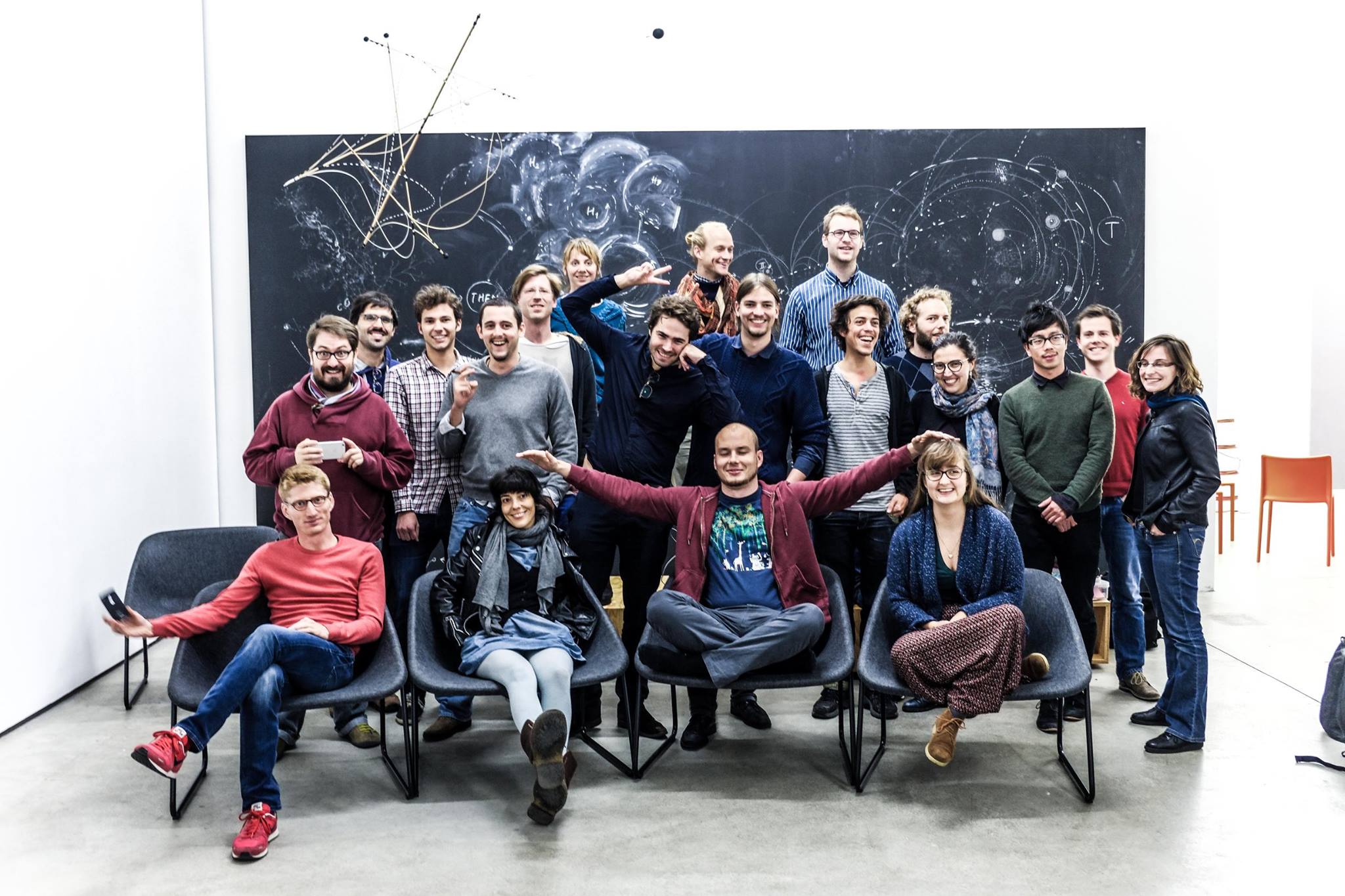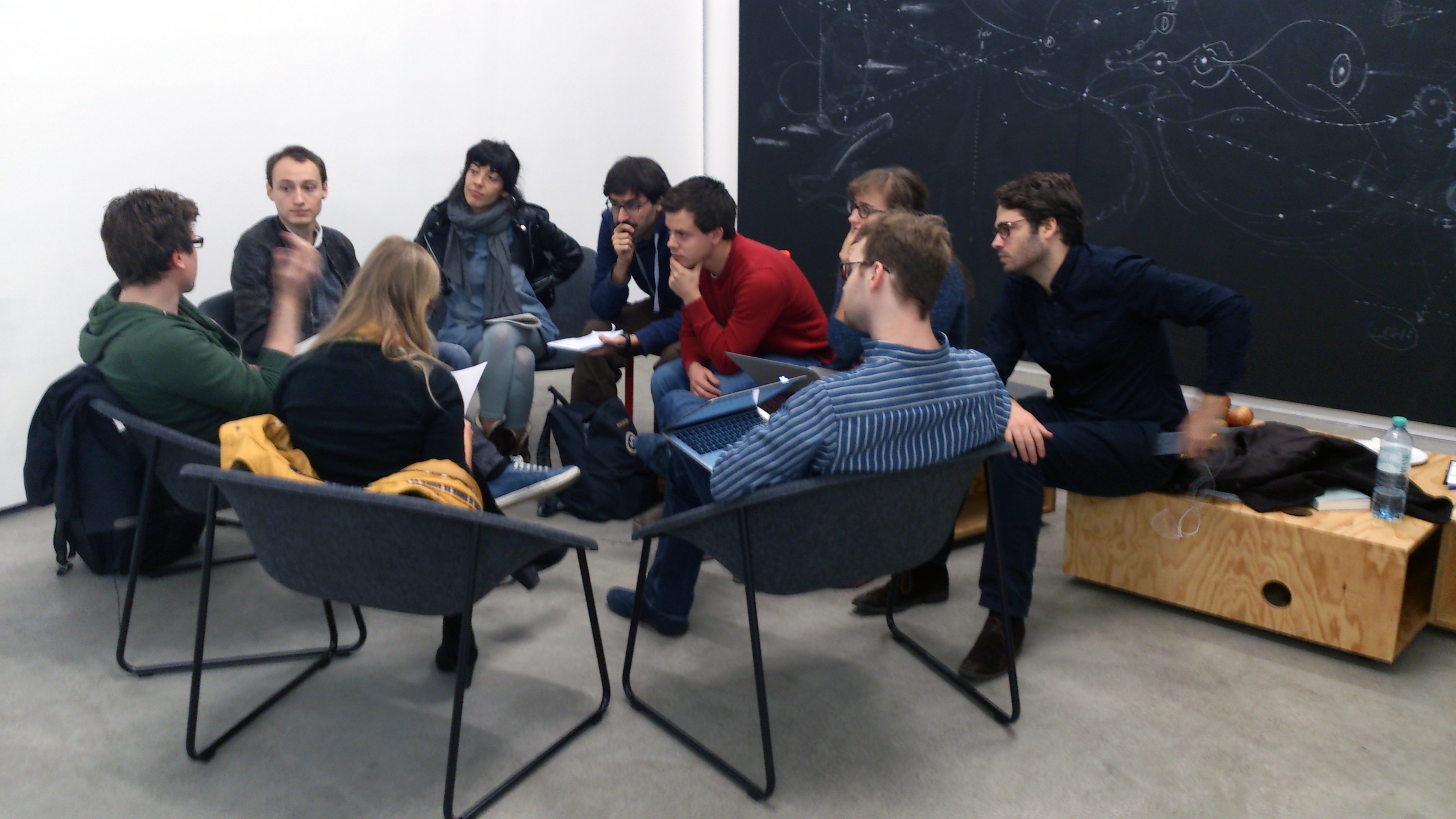DIYBio Europe and Biocommons Conference in Vienna 25th to 27th of October 2014
With the help of Synenergene and Biofaction (Bio-fiction) it was possible to hold a conference within the DIYBio Europe network and to pick up topics from the last Biocommons conference at Camp Pixelache 2014, organising a follow-up.
The first informal meeting on 25th October took place at 10 am in the cafeteria of Vienna’s Museum of Natural History. Due to bad acoustics, the meeting moved to a nearby Kaffeehaus, where the conference agenda was discussed in preparation for the conference the next morning.
On 26th October at 10 am the conference started at the Angewandte Innovation Lab, which is part of the University of Applied Arts in Vienna. Pieter van Boheemen from the Waag Society (Netherlands) kicked off the talks giving a complete overview of the Biostrike project and progress so far. Pieter mapped the complex difficulties of the antimicrobial resistance problem - from healthcare to agriculture, and the organisational difficulties in undertaking efficient measures - from finding, studying and classifying potent antibiotics to the development of safe applications. Two major obstacles in the organisation of Biostrike and other citizen science projects are the juridicial implications - from copyright and patent issues to biotechnology regulations affairs, and data and knowledge management.
The following talk by Rüdiger Trojok brought two technological solutions into the discussion, concerning the storage and distribution of information (findings, field data), the communication (exchange) with and the connection to other entities working on the antibiotics issue (e.g Pharma companies, academic and private funded research institutions, clinics, foreign aid NGOs). A Github application is online, in the development and testing phase. The currently desired lack of a formal/legal structure of the DIYBio network in Europe requires a decentralized way of data-management, independent from the goodwill of public or private organizations (e.g. IT costs, control over the data) of thus keeping political equality in a fragmented and maybe asymmetric network of DIYBio enthusiasts.
One conclusion from the Biostrike talks and discussions is, that in order to increase civic involvement in more complex problems with biotechnological qualities it is necessary to develop legal and political instruments for the promotion and protection of discoveries, findings and developments produced in a citizen science context. This is fundamental to the understanding of Biocommons. In discussions with legal experts, it was possible to learn juridicial mechanics, on the back of national and EU regulations and laws and on the background of a globalized economy, with it's agreements and obligations, identifying practicable steps to be taken by independent science (on an individual, or small group level). Further efforts are required to strengthen a mutual understanding and make progress in open source biotechnology.
The next talk was presented by Eugenio Battaglia on the Italian school initiative “La Buona Scuola”, where it is planned to “upgrade” schools with Hacker- and Biohackerspace-like structures to get more kids involved with the “future technologies” (e.g electronics, biotechnology) on the horizon. This can also be regarded as a success of the approach articulated by civic science movements like hackerspaces and open wetlabs around the world. Eugenio Battaglia also pointed out, that there are possible oscillation points between “La Buona Scuola” and Biostrike, which are being worked out at the moment.
After the Biostrike related talks three different workshops started discussing the legal, educational and technical/organizational aspects of Biostrike and interdependently Biocommons.
The workshop on legal aspects focussed on the understanding of Biocommons under aspects, like privacy and image rights, competition laws and regulations, fundamental rights, ethics and biosafety concerns, not touching much on IP (intellectual property) rights.
In the analysis of the existing licenses, which seem to fail, especially for the purpose of Biocommons, the question came up, if it is really necessary to obtain a patent or a Material Transfer Agreement (MTA)? Open licenses, cannot be regarded as an easy solution, as they combine MTA and IP contracts, which is more interesting for companies of a certain size.
A promising way to go is to concentrate on the aspect “new”, which is important in patent law. For instance an easy way to prevent a legal body from unjustly obtaining property rights is publishing. There are several innovative publishing methods to explore, like journals using ISBN, non-patent literature, archives and databases.
A conclusion of this workshop is that patents are not easy to use for inventors and that there are two options:
Firstly, thinking biohackers don’t need to create any property rights in this field at all and prioritise defensive publishing or copyleft measures. It will be hard to generate money for the inventor in this scenario. Secondly, creating a new form of right that is more user-friendly, e.g. biotechnology copyright.
As a result of the workshop a preferable scenario includes, MTA as an autonomous identity, no new legal rights resembling patents, but legal rights protecting inventions from exploitation, enforced by the state, thus becoming a “social norm”. Another inference drawn is that a suboptimal solution is better than no solution and therefore, identify the best starting point knowing that it will evolve. Create open access through defensive publishing.
The main objectives for educational measures (kits) as part of Biostrike have been identified as generating public awareness of and facilitating public participation in confronting the antibiotic crisis. Depending on the different competences and functions/missions different kits can be applied, whether used in the context of open wetlabs, universities, schools, policy making or other public spheres.
A possible structure includes:
An online platform with information on Biostrike including a collection or aggregation of working materials and the possibility to connect and contribute.
A physical kit, supplying materials, protocols and safety guidelines to cultivate microorganisms with the aim of finding antibiotics, by collecting, identifying (selective medium use and PCR/sequencing) and analyzing microorganisms and their antibiotic capabilities.
Educational materials to provide teaching help for the different educational formats.
To build up such a structure many different aspects must be considered, like funding (public or private) of the development, production and distribution of the kits, which will need a budget or business plan, and how to facilitate public understanding and mitigate false assumptions and paranoia. Legal and safety aspects are involved, too. Additional positive outcomes are expected from gamification.
The third workshop focussed on a internet based knowledge management using Github as an environment to aggregate and collectively work on findings, protocols and providing access and open Biostrike to public participation. A lot of work has to be put in the user interface to ensure greater accessibility.
Two presentations rounded off the first conference day: Raphael Kim from the London Biohackspace and Thomas Landrain from La Paillasse.
Raphael Kim encouraged DIYBio to be more daring by extending the horizon on what biohacking can do in the long term, suggesting two strategic positions:
Microbes as agents of politics and Biohacking as tool for speculation.
Giving examples of his work, Raphael Kim showed how the combination of speculative design and biohacking can be used as a thinking tool or method, with the potential to influence important social interactions.
Thomas Landrain reported on the latest developments at La Paillasse in Paris, which can be regarded as an astonishing transformation, from a small biohackerspace to a bioeconomy incubator, radiating a big sign of confidence in the future prospects of DIYBio.
On 27th of October at 11 am the conference continued with a presentation by María Boto Ordóñez on recent activities at the Waag in Amsterdam, which is impressively intensifying its citizen science activities.
Jaden Hastings introduced her works, which combine artistic and scientific qualities, questioning the construction of the self through technological representations.
The talks continued with Quitterie Largeteau and Aurélien Dailly, based at La Paillasse in Paris, showing their Biohacking Safari project, a photographic chronicle/worldmap of biohackers, visiting all the DIYBio communities starting in North America.
Bethan Wolfenden, presented the bento.lab, a powerful personal biotechnology tool of compact design with a PCR, a centrifuge and gel electrophoresis. The presentation showed the evolution of the Darwin Toolbox into bento.lab and also the first tests in the field at festivals and maker fairs.
Andreas Stürmer stimulated the discussion with the presentation of his Bee-O-Tex Technologies, to genetically engineer bees making them resistant to every single disease. Using the biological process of RNA interference, a reverse complementary fragment, which matches part of the virus' gene, is inserted into the bee's genome, thus producing RNA that binds to the viral RNA, which is then detected as an RNA hybrid and destroyed.
One of the founders of “OLGA”, the Open BioLab Graz Austria, Alexander Murer, introduced the KiloBaser, a remarkable start-up company developing rapid DNA prototyping, which has already caught the attention of the highest echelons of Synthetic Biology.
Malthe Borch, one of the founders of Biologigaragen, closed the conference showing the latest activities of Biologigaragen at the Kopenlab citizen science festival and the Medical Museion in Kopenhagen. His slides can be found here.
Many thanks to
Synenergene
Bio-fiction
AIL Angewandte Innovation Lab
Gerald Bast
Barbara Chlopcik
Christopher Coenen
Lucas Evers
Alexandra Graupner
Stephan Gruber
Jens Hauser
Thomas Margoni
María Boto Ordóñez
Markus Schmidt
Carolyn Thompson
Sandra Youssef

photo by daily laurel














